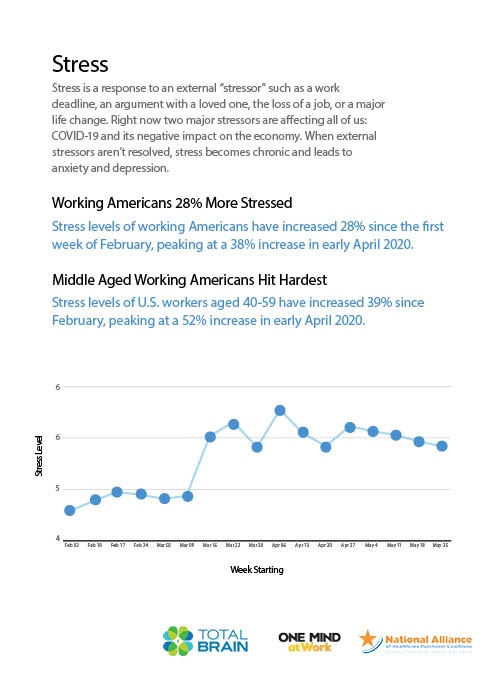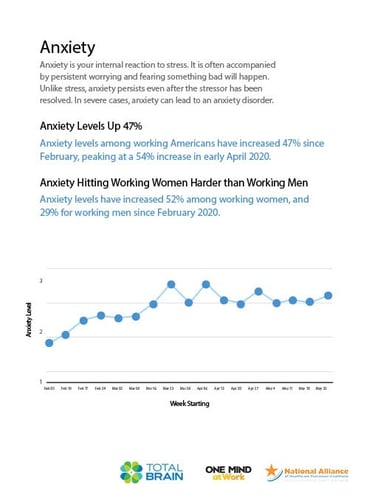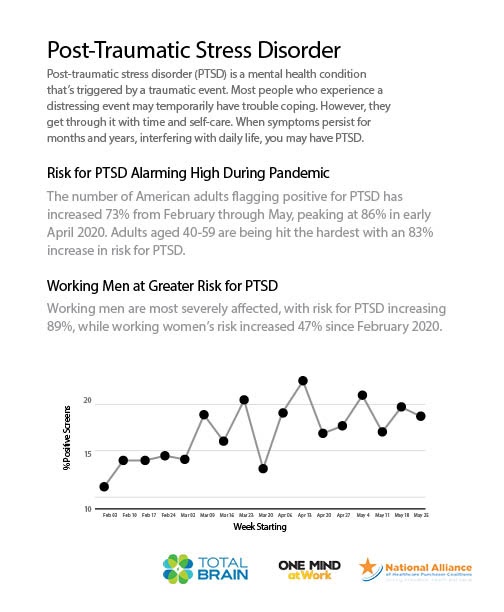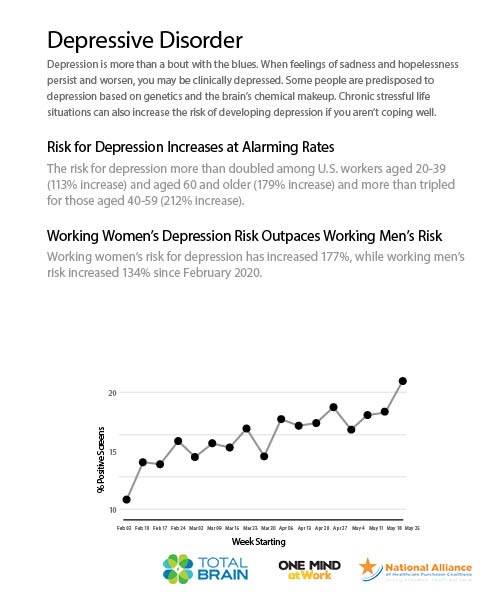By Donna Palmer on Fri, Jul 10, 2020
This week, Total Brain, in partnership with One Mind at Work and the National Alliance of Healthcare Purchaser Coalitions, released the May 2020 Update for the Mental Health Index: U.S. Worker Edition.
The first release of the Mental Health Index: U.S. Worker Edition revealed some startling findings regarding the mental wellness of American workers: from the period before the COVID-19 pandemic through to mid-April, levels of stress, anxiety, depressed mood, reduced cognitive function and more, spiked to unprecedented levels. This newest installment sheds light on how the mental health and wellness of American workers has changed over the past month, as the COVID-19 pandemic continues and other stressors, like conflict surrounding racial inequality, have increased.
There are endless takeaways and many compelling insights in the newly released May 2020 update of the Mental Health Index: U.S. Worker Edition, and you can review the key findings on our website. From this data, though, there are four fascinating findings that deserve closer examination:
- Minor improvements to mental health status have been observed overall, but stress and anxiety remain high
In mid-April, the Mental Health Index measured a 38% increase in feelings of stress and a 54% increase in anxiety. By the end of May, both had decreased slightly but still remained substantially elevated compared to the pre-COVID baseline: a 28% increase in stress and a 47% increase in anxiety were observed. These levels first spiked dramatically at the beginning of March, meaning American workers have been living with significantly elevated levels of stress and anxiety for the past three months.
It’s well-documented that long-term stress can cause or exacerbate numerous serious mental and physical health conditions, including anxiety, depression, cardiovascular disease, gastrointestinal problems and more. In fact, our new Data Insights and Impact Mental Health Update Report: Stress and Anxiety Tipping Point, delves into the trends and outcomes we might expect to see develop over the coming months as ongoing, elevated stress levels persist.
Fortunately, the Mental Health Index reveals trends starting to move in the right direction; but substantially more work must be done to get stress and anxiety under control. Taking action, like signing up for a free three-month subscription to the Total Brain app, allows you to measure the 12 brain capacities that define your mental health, screen for your risk of common mental conditions and begin a customized journey to improved mental performance through scientifically-validated brain-training exercises.

- Women and men are experiencing different mental health risks in response to stress
Increased stress associated with the COVID-19 pandemic and current events are affecting both men and women, but data from the Mental Health Index suggests the impact of that stress differs.
For women, stress has manifested in responses associated with anxiety and depression. For men, the Index shows a significantly higher risk for Post-Traumatic Stress Disorder (PTSD).
Anxiety levels for working women have increased 52% since February versus 29% for their male counterparts. Depressed mood has increased 83% for women versus 36% for men. Women are also at a greater risk than men for general anxiety disorder (98% vs. 67%) and depression (177% vs.134%).

When it comes to PTSD, this trend is reversed: the risk for working men has shot up by 89% compared to an increase of 47% for working women (although the absolute percentage of risk for PTSD still remains higher overall for women).

- Workers ages 40-59 have seen a greater increase in stress and anxiety compared to both their younger and older counterparts
Stress and anxiety levels are elevated across all age groups, but workers aged 40-59 have seen the biggest relative jump. The stress level in this group is up 39%, compared to an 18% increase in the younger demographic and no change for those workers over 60.
And while anxiety levels overall are higher in the 20-39 cohort, workers aged 40-59 have seen a greater growth in anxiety levels, with 75% higher anxiety levels compared to pre-pandemic measures. This same trend holds with risk of depressive disorders: workers aged 20-39 are still at a higher risk overall, but increase in risk has jumped most dramatically for those aged 40-59, a whopping 212%.

- Workers over 60 are experiencing less stress, anxiety and depression compared to measures taken at the height of the pandemic, but addiction levels skyrocket
For workers under 60, the heightened levels of stress, anxiety and depression have remained relatively consistent since levels peaked in mid-April, perhaps dropping slightly, but not significantly. For workers in the 60+ cohort, the data tells a different story.
While levels of stress, anxiety and depressed mood are still elevated compared to pre-pandemic measures, there have been respective reductions of 12%, 25% and 18% since the peak in mid-April. These numbers mean that the improvements seen in overall mental health measures may largely be attributed to this demographic, although not entirely.
While decreased levels of stress, depression and anxiety are good news, it’s not all positive for this demographic. Risk of falling victim to addiction has disproportionately risen for workers over 60, with a 208% spike in rates of addiction. The impacts of this metric could persist for years after the pandemic is resolved, and it’s essential that alternative coping strategies are implemented to support workers who are struggling with addiction in this new reality.
For each and every data point reported by the Mental Health Index: U.S. Worker Edition, multiple questions arise. Why are some workers experiencing the impacts of stress more intensely than others? What measures can individuals, governments and corporations take to improve mental wellness in the American workforce? How will these results impact the long term mental, physical, and economic health of the nation?
Empowering workers with tools to strengthen their emotion, feeling, self-control and cognition capacities is a good place to start. Understanding how your own workforce is faring compared to national benchmark data from the Mental Health Index can also prove insightful. To be the first to know about changes to the mental health status of the nation’s workforce, sign up to receive the latest editions of the Mental Health Index directly in your inbox.
About the Mental Health Index: U.S. Worker Edition
The Mental Health Index is created using data sourced from Total Brain platform participants, via standardized, digitally-based tasks and questions that detect a person’s conscious and unconscious experience of their brain functions. The measures focus on assessing:
- Behavioral, cognitive, and emotional responses to situations related to stress and coping;
- Autonomic nervous system over-activity (e.g. experiencing a racing heart or sweaty palms in everyday situations);
- Thoughts of worry or fear; and
- Feelings and experiences over the past week, with an emphasis on motivation.
The Total Brain team then performs statistical analysis of the data from a random sampling of up to 500 users each week. The sample used in the Mental Health Index was drawn from a universe of US workers that include most US regions, job levels, occupations, industries and types of organizations (public vs. private).




comments